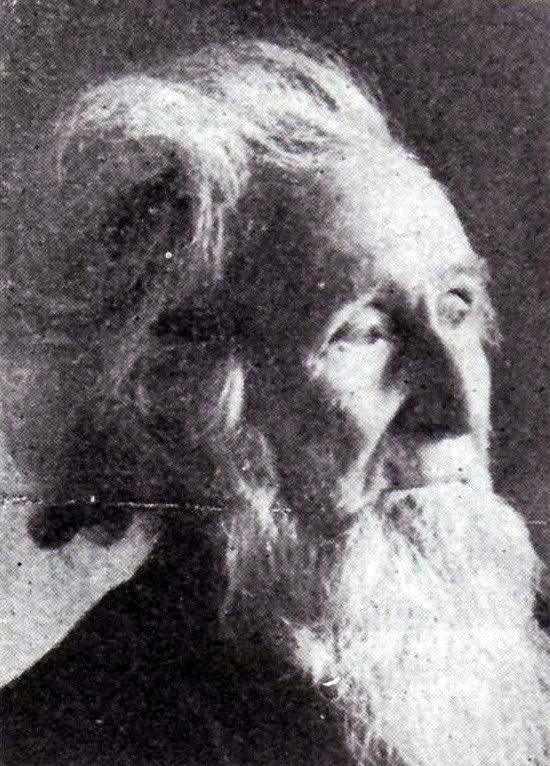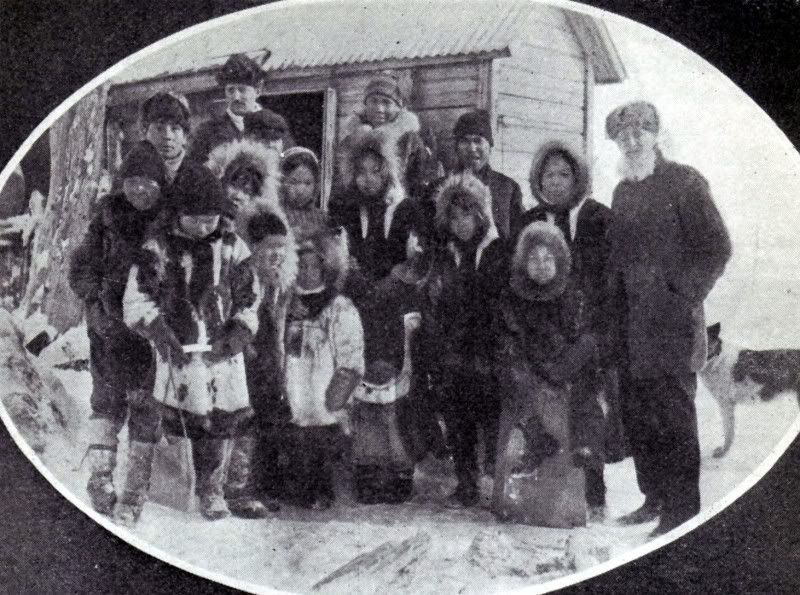“The first known baptism in Alaska occurred 25 June 1902, when Edward G. Cannon baptized K. N. Winnie in the Bering Sea near Nome.”
This statement is quoted or paraphrased in a number of histories of the Church in Alaska, sometimes with a comment about Elder Cannon’s tabernacle-on-wheels – oh, how I wish I had a photograph of that! – but without any more detail about these two remarkable men. While a great deal remains to be uncovered about their stories, here is more than you have probably ever heard before:
 Edward Guise Cannon was born on February 4, 1825, in Shelbyville, Kentucky. He was a veteran of the Mexican War of 1846. He was a Mason. He was a physician, although whether he was professionally trained I do not know. He married Barbara Mook of Grove, New York; how long she lived, or whether they had any children, I do not know. He was baptized in 1871 and sealed to his deceased wife in the Endowment House in 1873 – but again, how he learned of the Church, whether he was first baptized and then came to Utah, or was for some reason already visiting Utah when he learned of the gospel, I do not know.
Edward Guise Cannon was born on February 4, 1825, in Shelbyville, Kentucky. He was a veteran of the Mexican War of 1846. He was a Mason. He was a physician, although whether he was professionally trained I do not know. He married Barbara Mook of Grove, New York; how long she lived, or whether they had any children, I do not know. He was baptized in 1871 and sealed to his deceased wife in the Endowment House in 1873 – but again, how he learned of the Church, whether he was first baptized and then came to Utah, or was for some reason already visiting Utah when he learned of the gospel, I do not know.
I do know that he stayed in Utah, and practiced medicine in Ogden and Brigham City, and when he was an old man – past 75 years of age – he somehow took a notion to go to Alaska to pan for gold in one of the gold rushes at the end of the 19th century. He spent a year in the neighborhood of Nome, Alaska, in 1900 or 1901, staking out claims and getting a feel for the country, then returned to Ogden for a season to prepare for moving permanently to Alaska. “There are plenty of opportunities yet open to industrious, energetic men in the vicinity of Cape Nome,” he told the people of Ogden. “Trouble with hundreds is that they go to Alaska expecting to pick up a fortune without effort or labor and when they fail, they return with discouraging reports of the country.” Nome, he said, was far from a primitive wilderness – they had electric lights there, and a telephone system that was better than that of Salt Lake City.
Another major gap in my knowledge of Dr. Cannon’s story is whether, when he returned to Nome in the spring of 1902, he carried with him any formal commission as a Latter-day Saint missionary, or whether as a Latter-day Saint he simply couldn’t help himself, and preached the gospel because he believed it. Assistant Church Historian Andrew Jenson described Dr. Cannon as “president of the scattered Saints residing on the Seaward peninsula” at the time of his death. In any case, preach he did, and almost as soon as he returned to Alaska he baptized Kedzie Noble Winnie in what must have been the very cold waters of the Bering Sea.
 K.N. Winnie was a young man, born July 15, 1874 in Walton, New York. I assume he was in Alaska on a young man’s adventure. Whatever his intentions in going to Alaska, he could hardly have foreseen how he would spend the next eight years of his life, as the missionary companion and devoted friend of Dr. Cannon.
K.N. Winnie was a young man, born July 15, 1874 in Walton, New York. I assume he was in Alaska on a young man’s adventure. Whatever his intentions in going to Alaska, he could hardly have foreseen how he would spend the next eight years of his life, as the missionary companion and devoted friend of Dr. Cannon.
 One of their first joint endeavors was the operation of a school for Eskimos, conducted in 1903-04, which is believed to have been the first such organized school for the natives of Nome. In the accompanying picture, Dr. Cannon is the bearded man at the right edge of the group; Elder Winnie is the tall man standing in back. Elder Winnie may have had a particular interest in the native Alaskans; he wrote and sent to the Improvement Era (which apparently did not publish it) an illustrated paper on “the Eskimo, his Origin and Destiny,” written “with the view of doing good by directing the minds of the latter-day Saints throughout the world toward the Eskimo of the north country.”
One of their first joint endeavors was the operation of a school for Eskimos, conducted in 1903-04, which is believed to have been the first such organized school for the natives of Nome. In the accompanying picture, Dr. Cannon is the bearded man at the right edge of the group; Elder Winnie is the tall man standing in back. Elder Winnie may have had a particular interest in the native Alaskans; he wrote and sent to the Improvement Era (which apparently did not publish it) an illustrated paper on “the Eskimo, his Origin and Destiny,” written “with the view of doing good by directing the minds of the latter-day Saints throughout the world toward the Eskimo of the north country.”
The two preached the gospel on the streets of Nome and in surrounding settlements. They built Dr. Cannon’s mysterious portable “tabernacle” – Was it simply a wagon in which they traveled? Did it open to display some sort of church-like exhibit? Could it possibly have been large enough for the missionaries to meet inside with an investigator or two? I simply have no clue.
The pair subscribed to the Liahona: The Elders Journal, to which Elder Winnie wrote in 1908:
Nome, July 17
I have received my paper quite regularly and am confirmed daily in the faith by the testimonies of its pages. I know the gospel is true. I was baptized in the Behring Sea, in June, 1902. I knew Joseph Smith was a messenger sent from God before obeying the gospel. I feel the influence of the Spirit of the Lord in my life daily, making me a better man.
K.N. Winnie
While in Nome, Dr. Cannon’s home on Front Street (Elder Winnie apparently lived elsewhere) served as headquarters for the church. Its walls were decorated with mottoes: “Truth is eternal,” “The works of God continue,” “Improvement and progression have one eternal round,” “Be temperate in all things,” “The glory of God is intelligence,” “No man can be saved in ignorance.” Exactly how much Church activity existed in Nome is another unknown – there must have been a few other members, or a significant amount of investigator interest, because Elder Winnie reports holding meetings in the winter of 1908-09 for both whites and Eskimos (separate meetings, evidently), and the two men sought a permanent meeting place outside of Dr. Cannon’s home, a goal met by 1910, when Elder Winnie replied to “a scurrilous article on Prest. Brigham Young” which had appeared in Nome’s newspaper, The Daily Gold Digger,:
The only reason why any attention is given to a story of this character is that the warning voice may be sent out to the honest in heart of this place to beware of ‘wolves in sheep’s clothing,’ to beware of ‘them that loveth and maketh a lie.’ The glory of God is intelligence. Prejudice is the result of ignorance, of which this story is a sample, and is very misleading to say the least, from beginning to end and is of the unreliable, imported, manufactured kind.
A case where the facts (which could have been easily obtained) have been so garbled and twisted as to poison the minds of the people against honestly investigating for themselves ‘Mormonism, its Origin and Destiny.’ To the well informed man or woman, to those who have traveled, to those who know the Mormon people (not from a car window) dealt with them, lived with them, know that Joseph Smith was no mystic or charlatan, and that Brigham young was no soldier of fortune or adventurer. Truth is mighty and will prevail.
The Latter-day Saints are here to do all the good they can, and as has been stated before in the Nome papers are permanently located in their new meeting house on Lane’s Way near Fourth street, where a goodly supply of church literature may be obtained for the asking.
Edward Guise Cannon died in Nome in November 1910, two or three months shy of his 86th birthday.
Elder Winnie moved to Utah, where by 1913 he is described in one source as “of Salt Lake City.” On June 21, 1916, he married Sarah Witney, a girl from New Zealand, in the Salt Lake Temple. He was endowed the same day – he had served as a missionary for eight years on the strength of his baptism and his priesthood ordination, without benefit of temple blessings. He and Sarah lived in Goshen and Springville, Utah County, where they raised a family of at least four daughters and three sons, some of whom may still be living.
Kedzie Noble Winnie died in Payson on February 8, 1954, and is buried in Springville.
Continue reading at the original source →



